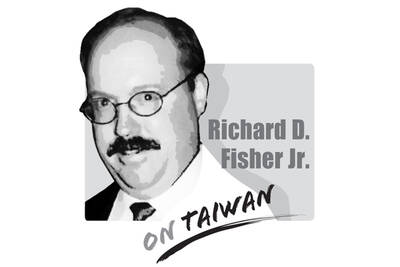An article published on July 4 in Hong Kong’s South China Morning Post, titled “Changing Taiwan ocean conditions could affect PLA’s [Chinese People’s Liberation Army] submarines,” cited a report that says increasing volcanic activity on the ocean floor near Japan’s Okinawa Islands has changed the water temperature off the east coast of Taiwan.
The temperature changes have, in turn, had an effect on the Kuroshio Current. The changes could affect submarine operations conducted in the area by the Chinese People’s Liberation Army Navy (PLAN).
From Taiwan’s perspective, defensive operations on its east coast could end up fending off attacks from two directions.
Due to the sheer size of the Pacific Ocean off Taiwan’s east coast, if the navy were able to draw its main fighting force into these waters before fighting broke out, and augment the force with a number of indigenous submarines currently under construction, naval commanders would be able to retain influence over dozens of the navy’s surface ships and many of its submarines.
Ships on the east coast could then be used as a standby maritime force that is able to launch a counterattack and, if needed, used to harass and impede PLAN assets in the Pacific Ocean. A naval force amassed on the east coast could also deny access to a PLAN aircraft carrier group and prevent it from attacking Taiwan’s east coast.
Chiashan Air Base (佳山基地) in Hualien County and Chihhang Air Base (志航基地) in Taitung County feature hardened underground facilities carved into a mountainside. If war with China breaks out, a large number of fighter aircraft at air bases on the west coast would be transferred to bases on the east coast in accordance with the military’s “force preservation” strategy.
The remaining aircraft stationed at bases on the west coast and in the south would be tasked as standby aircraft for frontline operations.
The air force views the east coast as inherently valuable in terms of force preservation, but also anticipates operating hand in glove with the navy to counterattack and harass the enemy.
The most effective way to defend Taiwan’s east coast is for the military to deny the PLA the opportunity to land aircraft and parachute in troops. Such an effort by the PLA could happen in two ways: One would involve a large number of helicopters that would fly across the Taiwan Strait carrying special-forces troops. Alternatively, two PLAN Type 072 Yukan-class amphibious landing ships could be tasked off Taiwan’s east coast on standby, which, once air and sea superiority have been achieved, would use their helicopters to conduct rapid attacks against Taiwan’s east coast air bases.
The latter would involve the use of PLA transport aircraft which, once air and sea superiority over Taiwan had been achieved, would be used to insert large quantities of equipment and soldiers by air. This would not only completely cut off reinforcements to Taiwan’s east coast, but could also be used to obstruct US forces rushing to Taiwan’s aid.
These scenarios help us appreciate the vital importance of Taiwan’s east coast to the nation’s defense. The Ministry of National Defense must therefore take steps to enhance the overall defense structure of Taiwan’s east coast. This could include increasing the number of air defense artillery battalions along the coast, deploying more anti-ship missiles, or positioning more electronic countermeasure systems in the field.
Ray Song is a graduate of National Chung Cheng University’s Institute of Strategic and International Affairs.
Translated by Edward Jones
On Sunday, 13 new urgent care centers (UCC) officially began operations across the six special municipalities. The purpose of the centers — which are open from 8am to midnight on Sundays and national holidays — is to reduce congestion in hospital emergency rooms, especially during the nine-day Lunar New Year holiday next year. It remains to be seen how effective these centers would be. For one, it is difficult for people to judge for themselves whether their condition warrants visiting a major hospital or a UCC — long-term public education and health promotions are necessary. Second, many emergency departments acknowledge
US President Donald Trump’s seemingly throwaway “Taiwan is Taiwan” statement has been appearing in headlines all over the media. Although it appears to have been made in passing, the comment nevertheless reveals something about Trump’s views and his understanding of Taiwan’s situation. In line with the Taiwan Relations Act, the US and Taiwan enjoy unofficial, but close economic, cultural and national defense ties. They lack official diplomatic relations, but maintain a partnership based on shared democratic values and strategic alignment. Excluding China, Taiwan maintains a level of diplomatic relations, official or otherwise, with many nations worldwide. It can be said that

Victory in conflict requires mastery of two “balances”: First, the balance of power, and second, the balance of error, or making sure that you do not make the most mistakes, thus helping your enemy’s victory. The Chinese Communist Party (CCP) has made a decisive and potentially fatal error by making an enemy of the Jewish Nation, centered today in the State of Israel but historically one of the great civilizations extending back at least 3,000 years. Mind you, no Israeli leader has ever publicly declared that “China is our enemy,” but on October 28, 2025, self-described Chinese People’s Armed Police (PAP) propaganda
Lockheed Martin on Tuesday responded to concerns over delayed shipments of F-16V Block 70 jets, saying it had added extra shifts on its production lines to accelerate progress. The Ministry of National Defense on Monday said that delivery of all 66 F-16V Block 70 jets — originally expected by the end of next year — would be pushed back due to production line relocations and global supply chain disruptions. Minister of National Defense Wellington Koo (顧立雄) said that Taiwan and the US are working to resolve the delays, adding that 50 of the aircraft are in production, with 10 scheduled for flight